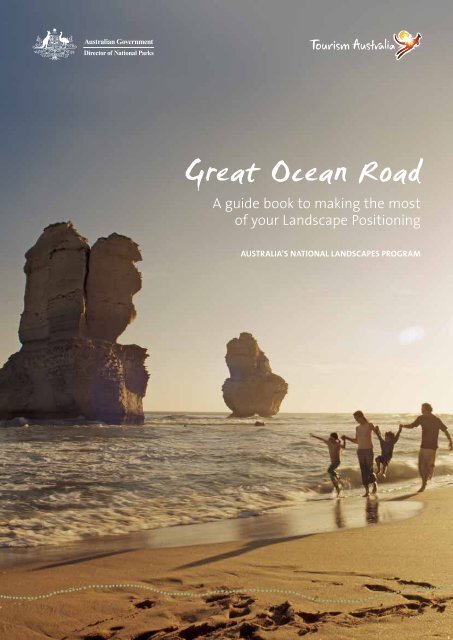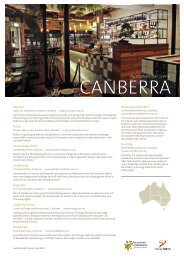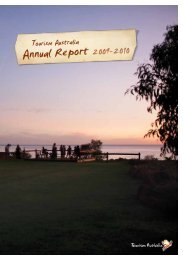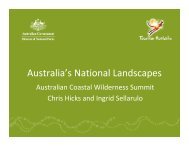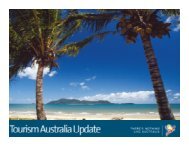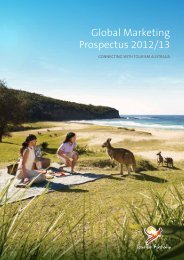Great Ocean Road - Tourism Australia
Great Ocean Road - Tourism Australia
Great Ocean Road - Tourism Australia
- No tags were found...
Create successful ePaper yourself
Turn your PDF publications into a flip-book with our unique Google optimized e-Paper software.
ContentsSECTION 1 3Introduction 4<strong>Great</strong> <strong>Ocean</strong> <strong>Road</strong> map 5SECTION 2 7What makes the <strong>Great</strong> <strong>Ocean</strong> <strong>Road</strong>Landscape unique in our world,not just <strong>Australia</strong>? 9The Landscape Positioning for the<strong>Great</strong> <strong>Ocean</strong> <strong>Road</strong> 11SECTION 3 13Building your business on the<strong>Great</strong> <strong>Ocean</strong> <strong>Road</strong> competitive position 14SECTION 4 20Maximising your communications with<strong>Great</strong> <strong>Ocean</strong> <strong>Road</strong> competitive position 22The language of<strong>Great</strong> <strong>Ocean</strong> <strong>Road</strong> 21SECTION 5 27More Information 27
Think of the<strong>Great</strong> <strong>Ocean</strong> <strong>Road</strong>as your land ofopportunity!OPPORTUNITY 1It’s one of 16 iconic <strong>Australia</strong>n National Landscapesmarketed worldwide by <strong>Tourism</strong> <strong>Australia</strong>.OPPORTUNITY 2That marketing is aimed at Experience Seekers:high yield, long-stay visitors looking for authentic andmemorable experiences.OPPORTUNITY 3A lot of research has already been done to identify the<strong>Great</strong> <strong>Ocean</strong> <strong>Road</strong>’s point-of-difference and unique experiences.OPPORTUNITY 4Designing and delivering quality experiences (either withinyour own business or in partnership with others) can improveand diversify your tourism offering.OPPORTUNITY 5World-class experiences will not only attract internationalvisitors, but also more <strong>Australia</strong>n visitors. There are plenty of<strong>Australia</strong>n Experience Seekers.The aim of this guide is to provide ideas and inspiration to help youdeliver the best experiences for your visitors and to help you prosper.This guidebook has been created for everyone involved inproviding or facilitating visitor services or who shares a commoninterest in this landscape, including:> > tour operators> > accommodation or hospitality establishments> > retail businesses> > tourism or discovery centres> > Indigenous groups or businesses> > local councils> > state or federal government agencies> > environment groups or protected area managers.In addition to the information supplied in this guidebook - thereare a number of worksheets available to download throughout thebook which will assist you with implementing ideas into yourown organisation.<strong>Great</strong> <strong>Ocean</strong> <strong>Road</strong> 2
Section 1<strong>Australia</strong>’sNational LandscapesNature motivates people to travel to <strong>Australia</strong>more than any other experience.Based on research conducted by <strong>Tourism</strong> <strong>Australia</strong> in 2010
AUSTRALIA’S TIMELESS NORTHTHE KIMBERLEYGREAT BARRIER REEFWET TROPICSNINGALOO –SHARK BAYAUSTRALIA’SRED CENTREFLINDERSRANGESAUSTRALIA’SGREEN CAULDRONGREATER BLUEMOUNTAINSGREAT SOUTHWEST EDGEKANGAROOISLANDAUSTRALIANALPSSYDNEYHARBOURGREAT OCEAN ROADAUSTRALIA’SCOASTAL WILDERNESSTASMANIA’SISLAND HERITAGEGet on board and help show the worldwhy there’s nothing like <strong>Australia</strong>What’s it all about?In research conducted by <strong>Tourism</strong> <strong>Australia</strong>, nature motivatespeople to travel to <strong>Australia</strong> more than any other experience.<strong>Australia</strong> therefore has the opportunity to be at the forefront of theglobal nature-based tourism industry.<strong>Australia</strong>’s National Landscapes Program is a partnership betweentourism and conservation, which aims to:> > promote <strong>Australia</strong>’s world-class, high quality visitor experiences> > increase the value of tourism to regional economies> > enhance the role of protected areas in those economies> > build support for protecting our natural and cultural assets.The program has identified <strong>Australia</strong>’s iconic natural and culturaldestinations and now aims to improve the delivery of quality visitorexperiences within them.Status of the Program<strong>Tourism</strong> <strong>Australia</strong> and Parks <strong>Australia</strong> partnered in 2005 todevelop <strong>Australia</strong>’s National Landscapes Program. Sincethen, 16 areas have joined the program, completing thecollection. <strong>Australia</strong>’s National Landscapes are shown above.In order to become a National Landscape, each areahad to undertake an extensive application process.National Landscapes accepted into the program areexpected to participate in a range of activities, such asLandscape Positioning and regional planning to underpinregional success.For further information visit www.tourism.australia.com/nlTo learn more about the National Landscape Programclick here to download the flyer.<strong>Great</strong> <strong>Ocean</strong> <strong>Road</strong> 4
HeathcoteBalmoralCastlemainePenolaAraratCastertonMount GambierHamiltonBallaratBacchus MarshPortlandWarrnamboolCamperdownGeelongTorquayApollo Bay<strong>Great</strong> <strong>Ocean</strong> <strong>Road</strong><strong>Road</strong>sNational Landscape AreaLocal Government AreasMap produced by:Environmental Resource Information Network (ERIN),© Commonwealth of <strong>Australia</strong>, Department ofSustainability, Environment, Water, Population &Communities, May 2012.Albers Equal Area projection on the GDA94 Datum.N:\Parks\terrestrial\all_parks\national_landscapes\mxd\guidebook_maps\national landscapes - great ocean road.mxd5 <strong>Great</strong> <strong>Ocean</strong> <strong>Road</strong>
It’s no surprise that <strong>Great</strong> <strong>Ocean</strong> <strong>Road</strong>has been chosen as one of <strong>Australia</strong>’sNational LandscapesHow will this benefit tourism in <strong>Great</strong> <strong>Ocean</strong> <strong>Road</strong> ?Let’s rephrase that question: Why should you align your business with<strong>Great</strong> <strong>Ocean</strong> <strong>Road</strong> and <strong>Australia</strong>’s National Landscapes Program?There are plenty of benefits. Here are some:1. Generate more income by responding to growinginternational and local demand for experientialtourism – longer stay, higher yielding customers.2. Gain an edge on your competitors – by aligning yourbusiness offering with your National Landscapes globalpoint-of-difference.3. Achieve higher yields by shifting to value-based pricing– because experience-based tourism is worth morethan goods or services.4. Earn a much greater return on investment - becauseexperience-based tourism isn’t about largeinvestments in capital infrastructure.5. Excite and inspire your employees – by developing anddelivering innovative, original tourism experiences thatcapture your customers’ emotions.8. Potential to develop partnerships that improve theeffectiveness of your marketing dollar.9. Opportunity to tap into potential partners andsuppliers who work with you to create fantasticexperiences for your guests.10. Potential to attract strategic investment or partnershipopportunities for your business.11. Opportunity to motivate and bring together membersof your local businesses community to help create anall-encompassing experience for your visitors.12. Global marketing support for <strong>Great</strong> <strong>Ocean</strong> <strong>Road</strong>experiences through <strong>Tourism</strong> <strong>Australia</strong>’s PR andmarketing activities.6. See happy customers become online and word-ofmouthadvocates for your business.7. See the changes in your business as your visitors staylonger and spend more - because of an enhancedexperience offering.<strong>Great</strong> <strong>Ocean</strong> <strong>Road</strong> 6
7 <strong>Great</strong> <strong>Ocean</strong> <strong>Road</strong>Did you know:Recent research fromTeletext Holidays revealedthat more than 25% ofBritons were moved tobook an exotic holiday afterseeing a Facebook friend’sholiday snaps online. Almostone fifth of those peoplealso admitted to bookingan identical trip.
Meet your best customer:The Experience SeekerExperience Seekers canbe found in any agegroup, income range,stage of life and comefrom many differentcountries, including<strong>Australia</strong>. They areadventurous and selfmotivated, love theoutdoors, and areecologically minded.THEY WANT:> > something different and unique> > natural, untouched environments> > opportunities for life-changingexperiences> > to understand and experiencelocal culture> > to discover something new> > to see the real <strong>Australia</strong>> > to gain knowledge> > ‘bragging rights’> > value for money.They are opinion leaders and advocateswithin their social circle. They sharetheir holiday experiences with peers,colleagues, friends and family. Theirinfluence and positive word-of-mouthcan secure you a return stream of likemindedvisitors into the future.Experience Seekers from aroundthe world tell us that they want toexperience something unique anddifferent. <strong>Australia</strong> promises them thatthis is the place where they can fulfiltheir dreams.Memorable, engaging visitorexperiences bring your LandscapePositioning to life. They help make<strong>Great</strong> <strong>Ocean</strong> <strong>Road</strong> a must-dodestination when visiting <strong>Australia</strong>.Deliver those experiences and yourExperience Seekers will tell the world!<strong>Great</strong> <strong>Ocean</strong> <strong>Road</strong> 8
Section 2What makes the<strong>Great</strong> <strong>Ocean</strong> <strong>Road</strong>Landscape uniquein the world, notjust <strong>Australia</strong>?
Each National Landscape offersa uniquely engaging experienceof nature and cultureFind the uniqueness – yourLandscape PositioningThe first step involved locals distilling what<strong>Great</strong> <strong>Ocean</strong> <strong>Road</strong> has that isn’t foundanywhere else in the world.Landscape Positioning workshops wereheld throughout the Landscape.The goal was to discover and documentthe core positioning that distinguishes<strong>Great</strong> <strong>Ocean</strong> <strong>Road</strong> from other Landscapesthroughout <strong>Australia</strong>.This agreed Landscape Positioning is notabout an advertising campaign, a newlogo or even a tag line. Positioning is theengine that drives the way you offer anddeliver your product now and for decades tocome. It permeates all experiences, creativeapproaches, communication and marketing.It’s what differentiates you. It’s yourcompetitive advantage.This is the unique voice of <strong>Great</strong> <strong>Ocean</strong> <strong>Road</strong>.Positioning underpins the words and imageswe use to sell our Landscape to the world. Themore consistently we all use those words andimages, the stronger our message.It’s what differentiates you. It’s yourcompetitive advantage.This is the unique voice of the FlindersRangers. Positioning underpins the wordsand images we use to sell our Landscape tothe world. The more consistently we alluse those words and images, the strongerour message.<strong>Great</strong> <strong>Ocean</strong> <strong>Road</strong> 10
The Landscape positioning for<strong>Great</strong> <strong>Ocean</strong> <strong>Road</strong>Wherenature’sdrama unfoldsat every turn.EssenceFreedom, exploration,passion and respectfor the power of nature.ValuesUnpredictable and moody – sometimesroaring ferociously and at other times gentlycalming. Dramatic and engaging, thisLandscape is magnetic and powerful. Vibrantand captivating, it is truly energizing.PersonalityThere is the thrill of driving or walking along the breathtaking<strong>Great</strong> <strong>Ocean</strong> <strong>Road</strong>. The environment is exciting and majestic butat the same time has a laidback coastal lifestyle, with village stopsalong the way. There is iconic scenery like the Twelve Apostles, as well asthe opportunity to get up close and personal with the <strong>Australia</strong>n wildlife,Aboriginal heritage and ever-changing scenery. The benefits are huge on botha physical and spiritual level. A sense of drama is strong in this landscape.Visitor benefitsThe world’s longest coastal road adjacent to the Southern <strong>Ocean</strong>. Diverseand spectacular natural formations, and dramatic scenery – Twelve Apostlesand Loch Ard Gorge; authentic surf culture (home to Bells Beach’s world-class surfing events,as well as surf brands Ripcurl and Quicksilver); abundant, diverse native wildlife; diverse naturalhabitats and landscapes (sandy beaches, coastal cliffs, rivers and forests); diverse range of walks,hikes, diving and activities; authentic coastal lifestyle – villages along the journey; maritime heritageand history – unique story. Building of the road. Clean and fresh.AttributesThe <strong>Great</strong> <strong>Ocean</strong> <strong>Road</strong> is a dramatic stretch of <strong>Australia</strong>’s coastline where the raw energyof the <strong>Great</strong> Southern <strong>Ocean</strong> abuts a spectacular landscape to create awe-inspiringscenery. A vast array of ever-changing landscapes, communities, habitats and wildlifewill captivate and invigorate.How do you embrace this positioning?It’s about how you, your business and the entire communityconnect with this unique identity. The more people (directlyor indirectly) who have some involvement projectingthe positioning, the quicker your target audience willunderstand what it is that makes your Landscape unique.‘Nature’s drama unfolds at every turn’ means you are free tospend time telling exciting stories that show your own loveof the <strong>Great</strong> <strong>Ocean</strong> <strong>Road</strong>.Think about the first time you came here. Think aboutwhat you love about this place, why you chose to be here.What makes the <strong>Great</strong> <strong>Ocean</strong> <strong>Road</strong> so special to YOU? Yourpassion is contagious. Tell visitors your stories. Share yourexperiences. Because that’s what they’re seeking.<strong>Great</strong> ocean <strong>Road</strong> is ‘nature’s drama unfolds at every turn’11 <strong>Great</strong> <strong>Ocean</strong> <strong>Road</strong>
What makes you unique?Consider what your landscape offers. The following chart was developed based on the original Landscapeapplication and evolved throughout the workshop positioning process. This chart highlights the keyvalidation to justify your central Positioning statement. This is the content (and context) that makes theExperience Seeker target market believe landscape <strong>Great</strong> <strong>Ocean</strong> <strong>Road</strong> is unlike anywhere else in the world.<strong>Road</strong> into historyThe <strong>Great</strong> <strong>Ocean</strong> <strong>Road</strong> was partof a major plan to create employmentfor soldiers returning from the First WorldWar. Fourteen years in construction, the <strong>Great</strong><strong>Ocean</strong> <strong>Road</strong> is today recognised as a massive featin engineering and planning and has been listedin <strong>Australia</strong>’s National Heritage list. Around 700ships are believed to have been wrecked alongthe Victorian coast, but less than a third of themhave been discovered. The ancient shipwrecks,which can be found along the coast line, telldramatic tales of tragedy and survival of<strong>Australia</strong>’s early European settlerstrying to start a new life.Weedy Sea DragonThe leafy-looking fins of the 46 centimetreweedy sea dragon provide excellentcamouflage as they swimamongst the seaweed.A livingoceanBeneath the ocean lies an explosionof life: 85 %of species found in the watershere are found nowhere else on earth, includingdeep sea and reef fish, sharks, dolphins, octopus, seadragons and the <strong>Australia</strong>n fur seal. Offshore reefsare home to brilliant sponge gardens and kelp forestswhere fish and other aquatic species make theirhomes. From June to September, the magnificentsouthern right whales come to the nutrientrichwaters around Warrnambool to breed.Mothers and calves have often beenfound as close as 100 metresfrom the shore.Geology inreal timeLimestone layers have eroded atdifferent rates to create tunnels andcaves as well as spectacular naturalstructures like the Twelve Apostles andthe Loch Ard Gorge. Erosion occurs at arapid rate as the awesome power of thesea pounds the earth – collapsing oneof the Twelve Apostles in 2005 andtumbling the London Bridgerock formation into thesea in 1990The <strong>Great</strong> <strong>Ocean</strong> <strong>Road</strong> is adramatic stretch of <strong>Australia</strong>’scoastline where the raw energyof the <strong>Great</strong> Southern <strong>Ocean</strong>meets a spectacular landscapeto create awe-inspiring scenery.A vast array of ever-changinglandscapes, communities,habitats and wildlife willcaptivate and invigorate.HeathlandsThe spectacular varietyof plants in the 7,500 hectareAnglesea heathlands burst into lifeduring spring to create an amazingwildflower display. More than 700 plantspecies have been recorded in the area,including 162 species in one hectarealone – the highest diversity of floraanywhere in Victoria. The 79 speciesof orchids found here makes itone of the most orchid-richsites in <strong>Australia</strong>.CoastallandscapesThe breathtaking cliff faces of the<strong>Great</strong> <strong>Ocean</strong> <strong>Road</strong> fall away to a spectacularmarine environment. The inter-tidal zonesupports a vast array of crabs, molluscs, fish,seaweed and algae, as well as fantastic bird life,including the internationally threatened peregrinefalcon. At the base of the famous Twelve Apostlesrock formation, a colony of around 1,000 littlepenguins can be seen from special viewingplatforms just after the sun goes down.Offshore islands provide a homefor the critically endangeredorange-bellied parrot.HinterlandsInland from the coastal landscapelies the cool, wet hinterland rainforests.Home to a variety of kangaroos, wallabies,possums, bandicoots, echidnas andbats, the <strong>Great</strong> Otway National Parkis a landscape of tall eucalypts andmysterious beach forests, rushingwaterfalls, cascading streams andsecret pockets of fern gullies.The <strong>Great</strong> <strong>Ocean</strong> WalkThe 104 kilometre <strong>Great</strong> <strong>Ocean</strong> Walkprovides an opportunity to experience arange of natural environments – tall forests,deserted beaches and remote cliff-tops. Thewalk’s ‘step-on, step-off’ means visitors canchoose to walk the whole or parts of the route,with options to pitch a tent or stay in luxuryaccommodation. For more informationgo to www.greatoceanwalk.com.au<strong>Great</strong> <strong>Ocean</strong> <strong>Road</strong> 12
Section 3Building your businesson <strong>Great</strong> <strong>Ocean</strong> <strong>Road</strong>Landscape Positioning13 <strong>Great</strong> <strong>Ocean</strong> <strong>Road</strong>
Building your business on the<strong>Great</strong> <strong>Ocean</strong> <strong>Road</strong> Landscape PositioningYour competitive advantage comesfrom turning this Landscape’scompetitive advantage into theEXPERIENCE you provide your visitors.Whether your business engages directly with visitors oroperates behind the scenes, your most valuable marketingtool is the experience you give your visitors. If theirexperience rates an 8/10 or more, you can expect word-ofmouthto help sell your product or National Landscape.So what is an ‘experience’? An experience is what yourvisitor gains from the combination of activities, settings andpersonal interactions they participate in when they visityour region. Think unique, unexpected and exotic; thingsthat your guests can’t do anywhere else in the world – thekinds of things that mean they’ll post a photo on Facebookstraight away and still talk about them at dinner partiestwenty years later.This overview includes ideas and thought starters whichcan help you build a real competitive advantage. Whenrefreshing your product or developing new experiences,consider how you could reflect the essence of nature’sdrama unfolds at every turn in everything you do.Ten years of economic research has shown that trueexperiential tourism is not only a real point-of-differencein a crowded market place, it’s also a product for whichExperience Seeker tourists are prepared to pay a premium.As an added bonus, experiences can be a much lower-costinvestment because they don’t necessarily involve capitalinfrastructure changes or upgrades.THE EXPERIENCE SPECTRUM AND YOUR BOTTOM LINEAs a business or organisation in <strong>Great</strong> <strong>Ocean</strong> <strong>Road</strong> you’reproviding goods and services to visitors at different pointson the Experience Spectrum. The higher your offerings areon the spectrum, the better your competitive positioningand the greater your returns.As you can see, the further along the spectrum the productis, the more special it is for your visitor, the more they willvalue it and the more they will be prepared to pay for it.Think about ways this spectrum can apply to your businessor service. The bare bones of the theory are:The commodity is the basic product which is available toeveryone. The goods are the tangible products we can sellbased on the commodity. The goods and commodities enableyou to add services. Goods and commodities provideopportunities to create an experience.To learn more about creating a more competitive offerclick hereExperience SpectrumCOMMODITY PRODUCT SERVICE EXPERIENCEThe following diagramshow the processfor moving fromoffering just individualcommodities, productsand services to offeringcompelling experiencesfood and winethat a restaurantsellsItems in therestaurant, such asthe menu, wine list,tables and chairsServices beingprovided to thecustomer witha smileA restaurant in a unique location,with history, serving local produceand wine - with the option of meetingthe chef or doing a cooking classUNDIFFERENTIATED LOW YIELDDIFFERENTIATED HIGH YIELD<strong>Great</strong> <strong>Ocean</strong> <strong>Road</strong> 14
Six Steps to Delivering a<strong>Great</strong> Visitor Experience1. Focus, Focus, Focus!> > Who is your target market and what experiencesdo they want?> > What do you want them to take away from theexperience: feelings, images, memories?> > What do you want them to be telling others aboutthe experience?> > You can’t be all things to all customers. But if you focus onExperience Seekers and provide memorable, world-classexperiences for them, the rest will come!2. What experiences fit with your business?> > What can your business offer?> > What community resources (natural and built physicalassets, community members and organisations) canyou involve?> > What partners/suppliers could you involve?4. Training and test flight> > Make sure your staff and any partners clearly understandyour guests’ expectations, the precise details of theexperience and their role in delivering it.> > Test the product in real time with non-paying ‘guests’ andtweak as needed.5. Market and communicate> > How will you market to potential consumers andto businesses?> > Increasingly, customers (actual and potential) talk toeach other. Will you monitor these conversations ormaybe join them?> > How will you maintain contact with past customers?6. Deliver, evaluate, modify3. Plan the experience> > Your guests should be as actively involved as possible -not passive spectators.> > Identify the theme around which you will build theExperience – look to your Landscape Positioningfor inspiration.> > The experience should involve their emotions and sensesand include a ‘wow!’ factor that makes it truly memorable.> > The experience must be authentic and ‘on brand’:consistent with Landscape Positioning.> > Plan every detail – such as timing to allow for visitorresponse and engagement, sequencing, best group size,safety and weather, dealing with guest physical limitations> > Remember, you are providing a world-class experience toa discerning market. Leave nothing to chance.> > Set your price – Experience Seekers will pay a premium fora premium experience (unique, authentic, personalised,‘wow!’), but have a well-developed sense of perceived value..GREAT CUSTOMER EXPERIENCES ARE:*> > A source of long-term competitive advantage> > Created by consistently exceeding customersphysical and emotional expectations> > Differentiated by stimulating emotion> > Enabled through inspirational leadership andfacilitated by culture> > Revenue generating and can reduce costs> > An embodiment of the Landscape Positioning*Colin Shaw, Revolutionize Your Customer Experience (2005)15 <strong>Great</strong> <strong>Ocean</strong> <strong>Road</strong>
THE POWER OF EXPERIENCESTony’s Sunrise Motel sells accommodation. The staff are politeand efficient, the place is immaculate and there’s a TV in everyroom. They even have an outdoor restaurant that sells fish,chicken and beef dinners. It’s a nice place to stay.Just like most other hotels in the world.There’s no way you would write a letter home, post onFacebook or brag about staying there, because Tony is selling“a nice place to stay”; a commonly available thing that is alsoavailable in London, Paris and Rome.But what if Tony offered more? What if he used hisnice place to stay to help sell experiences that people couldn’tget anywhere else?For example on Friday nights, Tony invites a local Aboriginalelder to share stories around the campfire. His guests have theoption of having dinner first and can order drinks at the bar.By the end of the night, Tony’s guests have probably boughta couple of drinks and eaten a meal BUT they’ve also learntabout local culture, enjoyed a connection with the Aboriginalpeople, posted a photo of themselves on Facebook withan Aboriginal elder and come away with the story of anexperience they can’t get anywhere else in the world.So, Tony has sold more because of the experience he’soffered his guests.Plus, when his guests’ friends decide they’d like this experiencetoo, because Tony’s is the only place offering it, the first partof the <strong>Australia</strong>n trip that they’ll book is two nights in Tony’sSunrise Motel.That’s the power of experiences.What’s the experience you could offer that yourguests can’t get anywhere else?<strong>Great</strong> <strong>Ocean</strong> <strong>Road</strong> 16
Here are some ideas for specificservice providersAccommodation suppliersIn this Landscape accommodation can be anything fromcamping in the freedom of the outdoors to a charmingbed and breakfast experience. Communicating nature’sdrama unfolds at every turn might be as simple as lettingyour guests know about a brilliant local theatre show whilethey’re checking in or it could be highlighting nature byleaving a sprig of local flora on their bed to greet them aftera long day out in the rainforest.You might like to help your visitors feel that sense of dramaby hosting an evening exhibition of local artists’ work andserve nibblies made from local produce. Or organise gettogethersor create a space where your guests can meet andshare their dramas from the day. Another way to help themexperience the drama is to highlight the perfect place towatch the thunderstorms as they roll in off the ocean.While you’re probably already doing this, you might like topair up with tour operators or other suppliers to packageexperiences. Think freedom, passion and exploration.You’d be surprised at just how many Experience Seekers areprepared to pay for tailored wilderness tours.Visitor Information CentresVisitor Information Centres are one of the most importantconnections the visitor has with your Landscape. This iswhere tourists from all over the world come to ask questionsand gather information. Think drama – instead of justhanding them a brochure share a dramatic story about thelast time you visited that particular beach or inlet, or tellthem about the dramatic stories in the history of the area.What about the layout, look and feel of your informationcentre? How does it encourage your visitors to experienceevery turn in their journey? Highlight community eventswhere they can meet the locals or activities that theycan get directly involved in such as species monitoring orcommunity clean up days. Set up a notice board wherevisitors can share their travel stories and contact details aswell as buy/sell camping equipment.Tour operatorsFor Experience Seekers it is vital the experience is authenticand provides a sense of what the local environment is like tolive in. The concept of nature’s drama unfolds at every turncan help you create and deliver amazing experiences.There may be an opportunity to plan the itinerary aroundthe concept nature’s drama unfolds at every turn by simplycreating product options. This might mean including anopportunity to hear a passionate talk from a friendly ranger,teaching them read the ocean waves, or how to distinguishbetween kangaroo species.Timing and interpretation is important in naturalenvironments: think about including time to listen to thebirds in the early morning, or how you’ll describe to yourguests what will ‘be around the corner’ on the tour today.Explain what they might feel or sense when they areswimming, hiking, and discovering native animals. Thinkabout how you explore the freedom of the powerful ocean,dramatic landscapes and passionate lifestyles.Make it exciting; make itcompelling. That’s drama.That’s the <strong>Great</strong> <strong>Ocean</strong> <strong>Road</strong>Landscape.17 <strong>Great</strong> <strong>Ocean</strong> <strong>Road</strong>
Retail, food and beverageWhile food and local produce will not be the prime reasonsExperience Seekers visit your Landscape, it is an integral part of‘word-of-mouth worthiness’. Be as passionate as you can withyour menu; create tastes exclusive to your Landscape withseasonal dishes and lots of local produce. Why not invitethem to participate in a cooking class featuring the catch ofthe day or other local produce? Your guests will feel a senseof experiencing nature’s drama when they get a chance to dosomething themselves.Share the insights of local dramatic experiences that you enjoy– whether it is a spellbinding spot for sunset views or the talesof tragedy and survival linked to the ancient shipwrecks foundalong the coastline. Visitors are looking to share the locals’experiences.Consider stocking, or becoming an outlet for, locally madeproducts, wines and crafts. Another idea is to hang some localphotography or imagery on your walls to share with the visitor.You could also make arrangements to display local artists’work for sale.Point visitors to local suppliers, a business down the road orin the next town. If you know the owner of the business, tellyour visitors to ‘mention my name and they’ll look after you.’This is also a great way to build business networks acrossthe Landscape. Why not see how many visitors you can eachrefer to the other? The Experience Seeker is looking for localproduce and local knowledge.thing about...’. Local art competition prizes could be awardedto the artwork or photograph that best reflects the essence ofturning the corner.To build community understanding of the region’s uniqueposition, you can also reflect the messages in yourcommunications – such as local newsletters, media releases orother regular communication materials.Planning and infrastructure developmentThe Landscape Positioning concept of nature’s dramaunfolds at every turn can also be applied when planninginfrastructure. In assessing development applications,designing visitor infrastructure, or even considering theplacement of signage, ask yourself questions like:> > How does this development complement the Landscapevalues – freedom, exploration, passion or respect for thepower of nature?> > Does this infrastructure provide the visitor withunhindered views that let them appreciate the power ofthe environment?> > How does the development encourage visitors toexperience the drama in the environment for themselvesor help the landscape to unfold?> > How do the colours and materials used complement theexploration of the environment?Local councils and government agenciesThink about all the ways these agencies communicate withlocals and visitors, both directly and indirectly. Considersignage, community services and public infrastructure. All canportray the concepts of nature’s drama unfolds at every turn.Why not use your positioning to set the theme for communitydevelopment initiatives or school competitions. A creativewriting competition could be themed ‘The most dramatic<strong>Great</strong> <strong>Ocean</strong> <strong>Road</strong> 18
Highlighting your uniquenessto visitorsEventsConsider theming events around the concept of nature’sdrama. When supporting local community events youmight like to include criteria that ask the participants ororganisers to describe how they will reflect the LandscapePositioning. Events that feature your natural environmentwill help position the Landscape in the visitor’s mind.Whatever you consider, try to relate it back to somethingan Experience Seeker would love to be able to share withfriends. Think of the ‘brag-ability’ factor. Remember, theycan post on Facebook within minutes to share the story ofyour Landscape.Environment and cultural interpretationThere are exceptional stories to be told and experiences thatcan be built around different environment that are naturallydramatic. Where the <strong>Great</strong> Southern <strong>Ocean</strong> meets the cliffsis obviously dramatic, creating awe-inspiring scenery anda vast array of ever-changing landscapes. The stories ofthe ancient shipwrecks are quite literally dramatic: spotswhere the hopes and dreams of early European settlers werethrown against the harsh <strong>Australia</strong>n landscape.program to collect native seeds, document wildlife throughphotographs, or help rehabilitate frog breeding sites(www.conservationvolunteers.com.au).Personal touches for allStories of your Landscape can live at every touch point.Consider your phone message - you could even create a storyabout the environment to engage with the customer whilethey are on hold.To help build understanding, you might like to incorporateinformation on the positioning in employee briefings,orientation and customer service training programs.Encourage your employees to consider how the conceptof nature’s drama unfolds at every turn fits with theirexperience of the Landscape or lifestyle and how they mightbe able to incorporate it into their customer service.To assist your own product and experience development,take a moment to assess your current situation using thefollowing product development worksheetClick here to download the Product Development WorksheetInform tourists about the hands-on approach takento conservation activities along the <strong>Great</strong> <strong>Ocean</strong> <strong>Road</strong>.Encourage them to report a whale sighting (http://visitgreatoceanroad.org.au/whale-sightings), or get theirhands dirty by joining the <strong>Great</strong> <strong>Ocean</strong> <strong>Road</strong> Committee treeplanting or weeding session (www.gorcc.com.au). If they’reparticularly enthusiastic about conservation, recommendthey take part in the Conservation Volunteers <strong>Australia</strong>19 <strong>Great</strong> <strong>Ocean</strong> <strong>Road</strong>
Section 4Maximising yourcommunications withthe <strong>Great</strong> <strong>Ocean</strong> <strong>Road</strong>Landscape Position
The language of the <strong>Great</strong> <strong>Ocean</strong> <strong>Road</strong>‘Nature’s drama’ is the feeling the Experience Seeker will get from the<strong>Great</strong> <strong>Ocean</strong> <strong>Road</strong>’s Landscape.This emotional territory connects the visitor at asubconscious level to the emotional space of the<strong>Great</strong> <strong>Ocean</strong> <strong>Road</strong>.This essence should drive all creative thinking forcommunication, advertising and public relationsand relay the message of how the <strong>Great</strong> <strong>Ocean</strong><strong>Road</strong> experience creates a desire for drama in theinternational experience seeker.‘Drama’ is the core essence of the intangiblemessages that come through in your Landscape.In particular, through positioning workshopsconducted earlier with key opinion leaders in yourarea, your Landscape was found to be:> > a place where incredible biodiversity is a key attribute> > a world-class experience, especially the<strong>Great</strong> <strong>Ocean</strong> Walk> > loaded with convenient, comfortable and civilizedaccommodation and dining, offering an immersive‘soft’ adventure experience> > a relaxed, surfie environment, relatively free ofcrowds> > a pristine environment of untouched coastline> > a place to immerse and interact with nature in a veryintimate environment> > all manner of wildlife and people> > untapped, raw landscapes offering an abundantarray of life> > connected with nature in an incredibly innocent way.To assist with your own communication planning,take a moment to assess your current situationusing the communication worksheetClick here to download communications worksheet21 <strong>Great</strong> <strong>Ocean</strong> <strong>Road</strong>
How you can convey thevoice of the <strong>Great</strong> <strong>Ocean</strong> <strong>Road</strong>Editorial StyleThe best approach to editorial style is based on an awarenessof what motivates our key target: the Experience Seeker. Theyare seeking information and rich copywriting enables them toget into the potential experience. Be descriptive and honest,clear and informative. Refer the reader to websites whereapplicable, rather than writing too much. Always leave thereader wanting a little more. Remember the positioning isbased around nature’s drama unfolds at every turn so considerthis when you are constructing your editorial copy.Key wordsThis is an important aspect of your communications.Words should be tied back to the essence of yourLandscape. Words such as:dramaticapplauseemotiondirector’s seatlights, camera, actionenthrallingunspoiltpristineabundantuntouchedfriendlyHow does this look when you consider itrepresented as a word matrix?dramaticdirectors seatfriendlyabundant emotionnaturalpristinevividapplauseuntouchedlights, camera, action> > experience the drama of <strong>Australia</strong>’sshipwreck coast> > exciting surf conditions> > dramatic waterfalls> > spectacular natural formations> > a living natural aquarium to dive into> > visit Mother Nature’s weekender and stay awhile> > it’s an untouched, pristine environment> > Nature’s drama unfolds at every turn> > unspoilt wilderness, majestic coast and people to meet> > a region connecting locals with extraordinary marine life> > stunning contrasts, vivid colours, changing contours> > incomparable experiencesallure> > the unique splendid isolation of unspoilt beauty> > experience a pristine environment ofuntouched coastline> > cool nights, warm days, clear skies.unspoiltenthrallingdiverse<strong>Great</strong> <strong>Ocean</strong> <strong>Road</strong> 22
Speaking in one voiceWhen presenting your Landscape, it is important you speak as bestyou can with one voice. Embracing the essence of nature’s dramaunfolds at every turn and presenting this in a way that supports yourproduct adds to the cumulative experience visitors will seek. Theywill spend time across a range of locations, events and experiences.You must make sure every one of their touch points culminates intheir high praise of the overall experience.Connecting to ‘revealing’We have identified the following words you might alsoconsider. These words all have an association with the essenceand could be used when drafting copy for advertising material orpress releases.Primary Word Out Takes= Theatrical: flamboyant, imposing, fascinating, compelling,mesmerizing, attractive.= Passionate: rapturous, incredible, intense, vibrant, worshipful,ardent, smitten, impetuous, beautiful= Captivating: enthrall, hypnotise, fascinate, mesmerise, enchant,charm, hold your interest, newsworthy.= Entertaining: diverting, pleasurable, enjoyable, festive, absorbing.Secondary word out takesUnpredictable: unrestrained and unrestricted,untamed, natural habitat.Powerful: awe-inspiring, commanding, impressive,gripping, fascinating.Magnetic: compelling, force of nature, alluring,centre of attraction, charming.Vibrant: vigorous, spirited, lively, fizz, verve, exciting,ebullient, intense.23 <strong>Great</strong> <strong>Ocean</strong> <strong>Road</strong>
The coloursIt is important to use colour and image in a way that issympathetic to the core values of the <strong>Great</strong> <strong>Ocean</strong> <strong>Road</strong>.The colours shown here are suggestions only. This exampleillustrates how a family of colour can be built and thenapplied. The colours shown here are from the palette of theheathlands and the contrast of the oceans and the forest.These colours represent the earth, but also the unique andvaried experiences one can expect on a journey through the<strong>Great</strong> <strong>Ocean</strong> <strong>Road</strong>.Consistent use of photographyIn order to keep us all speaking with one voice, we haveincluded examples of photography that represent the look,tone and feel of the <strong>Great</strong> <strong>Ocean</strong> <strong>Road</strong>. It’s part of the visuallanguage of the <strong>Great</strong> <strong>Ocean</strong> <strong>Road</strong> and it needs to be just asconsistent as the spoken and written voice. This will give theExperience Seeker a clear message about what makes the<strong>Great</strong> <strong>Ocean</strong> <strong>Road</strong> unique in the world. Remember, it’s idealto have people in the majority of your photographs to bringthe experience on offer to life.<strong>Tourism</strong> <strong>Australia</strong> has an outstanding photo gallery librarywhich is available for all tourism operators to look through,consider and utilise free of charge.For reference visit www.images.australia.comFor more information on what makes a great imagevisit www.tourism.australia.com/images<strong>Great</strong> <strong>Ocean</strong> <strong>Road</strong> 24
How you can use your Landscape Positioningin your communicationsBeing part of the National Landscapes Program means your operation isrecognised as belonging to a region renowned for its outstanding naturalbeauty and cultural significance.You communicate with visitors and potential visitors toyour region in a myriad of ways. Each interaction betweenvisitors and your business is an opportunity to reinforce yourLandscape’s Landscape Positioning.This section of the guidebook offers suggestions for utilisingthe positioning in your marketing activity communications,as well as suggestions to help you make the most of yourcontact with visitors. Some of these can be implementedin the short term, without cost implications, and others arelonger-term goals to be integrated in your business activitiesas they arise over time – such as brochure re-prints orwebsite updating and design.These are guidelines only – it’s important to keep in contactwith your local tourism officer.A collection of content has been created to assist youwith your communication of your landscape.These include factsheets for media and consumer,suggested itineraries and conservation factsheetsand wildlife calendarClick here to download Factsheets, Itineraries,Conservation Fact sheets and Wildlife CalendarWebsite and Social MediaConsistent presentation of your Landscape Positioningonline will give potential visitors, including web tourists,a clear picture of what makes your Landscape a uniqueplace. That’s why it’s important for all stakeholders to useconsistent visual, spoken and written language of theLandscape, across all touch points.Another opportunity to differentiate your business is to seeif you can reflect the essence of your Landscape in the styleof your writing or communications.> > Your Landscape Positioning may be communicated in amore personal tone; you can be yourself– genuineand sincere.> > Incorporate sections on your site that can be updatedeasily and frequently - a blog, Twitter or Facebook –stylestatus updates to communicate fascinating facts to grabinterest.> > If you haven’t already, consider establishing a social mediapresence as a means of staying in touch with your visitorsin real time.> > For example, you could upload this morning’s sunrisepictures, wildlife sightings, weather conditions,information on community activities and events.> > Photos of your staff or family enjoying the landscape willdemonstrate that visitors will have the chance to do whatthe locals do.With positioning values such as ‘freedom, exploration, passionand respect for the power of nature’ the world of social mediaoffers ideal opportunities to connect with past, present andfuture visitors.The <strong>Tourism</strong> e-kit is an online marketing program, designedspecifically for the tourism industry, to assist you to makethe most of opportunities the internet providesClick here to download the <strong>Tourism</strong> e-kitIn developing a new website, or when updating contenton your current site, aim to incorporate iconic images,colours from the region, and a selection of the key phrasesand descriptive words that arose from the Landscape’spositioning workshops (See page 22) .25 <strong>Great</strong> <strong>Ocean</strong> <strong>Road</strong>
Stationery> > When updating your corporate stationery, considerincluding your Landscape’s colour palette.> > You could add a one-liner logo that reflects your businessvision and incorporates primary words or key phrases.> > Dare to be a little unrestrained –you can resist the ‘norm’of corporate stationery design and reflect the personalityof your business and the region.> > Take the opportunity to add a friendly handwrittenmessage when sending hard copy confirmations toguests, an easy way of being sincere and open.> > If undertaking your own advertising or PR campaign,choose media outlets or publications that target theExperience Seeker market.> > Public relations messages can be built on the key phrasesand supported by appropriate images.> > If you participate in a competition by providing giveaways, influence the theme of the competition to alignwith key phrases or words.Brochures, signage and visitor informationincluding information provided enroute / tour interpretivematerial / hotel compendiums/ waiting room readingmaterial / reception signage> > When you are due to redesign and print your brochures orsignage, consider using the Landscape’s colour palette.> > Think of the key phrases and words you could use to makean emotional connection with Experience Seekers anddevelop consistency with others within your Landscape.> > Chose images to reflect the personality of your Landscapeand your business.> > Ancillary service providers within the community(gear hire, local shops, medical centres, post offices, etc)can also assist with delivering a consistent experienceby using and reflecting key messages and offeringvisitor information.PR / advertising> > Where possible always link in with broader regionalinitiatives – the work of your local, regional, and statetourism organisations.Social Media<strong>Tourism</strong> <strong>Australia</strong>’s Facebook page receives over 1,000photos a week from fans. The industry is also invitedto post their own photos to the wall. Every Friday thebest are chosen and featured in the Friday fan photoalbum. The photos that resonate best with fans are alsoshowcased as their own individual post and sent to ourfans globally.The ‘things to do’ tab on <strong>Tourism</strong> <strong>Australia</strong>’s Facebookfan page allows <strong>Australia</strong>n businesses to add their pagesand events directly onto the <strong>Australia</strong> page. Acting asa directory for fans of <strong>Australia</strong>, the tab allows usersto search for places and events by location, experienceand date – and then click through to find out more.Information added will receive exposure to the 3 millionplus <strong>Australia</strong> Facebook fans around the world.To add listings visit www.facebook.com/seeaustralia,click ‘things to do’ on the left then ‘add your Facebookpage’ at the bottom of the screen.<strong>Great</strong> <strong>Ocean</strong> <strong>Road</strong> 26
Section 5MoreInformation
MAKING YOUR BUSINESS EVENMORE SUCCESSFULHere are 10 ideas you might want toconsider and perhaps apply to yourbusiness planning. Not everything willbe relevant but even one idea appliedsuccessfully can make a big difference.1. Make use of your customer data2. Create profiles of yourbest customers3. Track them down and lookfor clones4. Enter your Experience Seekersmedia world5. Pay less and still dominate6. Create advocates for your business7. Identify what is attractive about yourarea or location8. Make them an offer to stay or comeback soonWe hope you have foundthis guide helpful and that itinspires you to think of waysyou can make positive changesto your business or service.With your region being chosen as one of <strong>Australia</strong>’sNational Landscapes there is a significant opportunityfor all stakeholders within the region to work andprosper together.Your Landscape’s unique Landscape Positioning will bebuilt over time, through your individual contributions,creating opportunities for long-term success. Your aimshould be to consistently deliver great experiences andbuild strong awareness of your destination.This may be in obvious ways or in the subtlest of ways.We wish you every success.9. Introduce them to everyone whoyou think will help create a positiveexperience for them10. Don’t forget them whenthey leaveClick here to find out moreabout these ideasFOR FURTHER INFORMATION, HERE ARESOME USEFUL LINKS...<strong>Tourism</strong> <strong>Australia</strong> corporate sitewww.tourism.australia.com<strong>Australia</strong>’s National Landscapes sitewww.australia.com/nlPlanning for Inbound Successwww.tourism.australia.com/inboundsuccessBoosting your Bottom Linewww.tourism.australia.com/boostbottomlineMaking a Splash (generating publicity)www.tourism.australia.com/makingasplash<strong>Tourism</strong> e-kit (lessons on e-marketing)www.atdw.com.au/tourism_e_kit.asp


